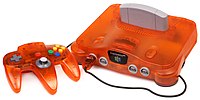Nintendo 64 accessories
This article needs additional citations for verification. (March 2009) |
The list of Nintendo 64 accessories includes first party Nintendo hardware—and third party hardware, licensed and unlicensed. Nintendo's first party accessories are mainly transformative system expansions: the 64DD Internet multimedia platform, with a floppy drive, video capture and editor, game building setup, web browser, and online service; the controller plus its own expansions for storage and rumble feedback; and the RAM-boosting Expansion Pak for big improvements in graphics and gameplay. Third party accessories include the essential game developer tools built by SGI and SN Systems on Nintendo's behalf, an unlicensed SharkWire online service, and unlicensed cheaper counterparts to first party items. The Nintendo 64 video game console had a market lifespan from 1996 to 2002.
First-party[]
First party Nintendo 64 accessories have a product code prefixed with NUS, short for "Nintendo Ultra Sixty-four".[1][2]
Controller[]
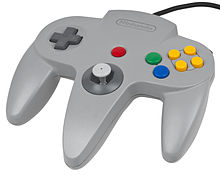
The Nintendo 64 controller (NUS-005) is an "m"-shaped controller with 10 buttons (A, B, C-Up, C-Down, C-Left, C-Right, L, R, Z, and Start), one analog stick in the center, a digital directional pad on the left side, and an extension port on the back for many of the system's accessories. Initially available in the seven colors of gray, yellow, green, red, blue, purple, and black, and it was later released in translucent versions of those colors except gray.
Controller Pak[]
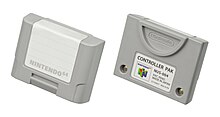
The Controller Pak[a] (NUS-004) is the console's memory card, comparable to those seen in the PlayStation and other CD-ROM-based video game consoles. Certain games allow saving of game files to the Controller Pak, which plugs into the back of the Nintendo 64 controller (as do the Rumble and Transfer Paks). The Controller Pak was marketed as a way to exchange data with other Nintendo 64 owners, since information saved on the game cartridge can not be transferred between cartridges.
It is plugged into the controller and allows the player to save game progress and configuration. The original models from Nintendo offered 256 kilobits (32KB) battery backed SRAM, split into 123 pages with a limitation of 16 save files, but third party models have much more, often in the form of 4 selectable memory banks of 256kbits.[3] The number of pages that a game occupies varies, sometimes using the entire card. It is powered by a common CR2032 battery.[4]
Upon launch, the Controller Pak was initially useful, and even necessary for earlier Nintendo 64 games. Over time, the Controller Pak lost popularity to the convenience of a battery backed SRAM or EEPROM found in some cartridges. Because the Nintendo 64 uses a Game Pak cartridge format that allows saving data on the cartridge itself, few first party and second party games use the Controller Pak.[5] The vast majority are from third-party developers. This is most likely due to the increased production and retail costs which would have been caused by including self-contained data on the cartridge. Some games use it to save optional data that is too large for the cartridge, such as Mario Kart 64, which uses 121 of the total 123 pages for storing ghost data,[6] or International Superstar Soccer 64, which uses up the entire cartridge's space for its save data. Tony Hawk's Pro Skater uses 11 pages.[7] Quest 64 and Mystical Ninja Starring Goemon use the Controller Pak exclusively for saved data. The Japan-only game Animal Forest uses the Controller Pak to travel to other towns.
Following the 1996 Christmas Shopping Season, Next Generation reported "impressive sales of the memory pack cartridges despite the lack of available games to take advantage of the $19.99 units".[8]
Jumper Pak []

The Jumper Pak[b] (NUS-008) is a filler that plugs into the console's memory expansion port.[9] It serves no functional purpose other than to terminate the Rambus bus in the absence of the Expansion Pak.[10] This is functionally equivalent to a continuity RIMM in a Rambus motherboard filling the unused RIMM sockets until the user upgrades. Nintendo 64 consoles were shipped with the Jumper Pak included and already installed.[11] Jumper Paks were not sold individually in stores and could only be ordered through Nintendo's online store. The system requires the Jumper Pak when the Expansion Pak is not present or else there will be no picture on the TV screen.
Expansion Pak[]
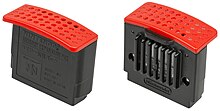
The Expansion Pak[c] (NUS-007) consists of 4 MB (megabytes) of random access memory (RAM)—which is RDRAM, the same type of memory used inside the console itself[10]—increasing the Nintendo 64 console's RAM from 4 MB to 8 MB of contiguous main memory.[10] It is installed in a port on top of the console and replaces the pre-installed Jumper Pak, which is simply a Rambus terminator.[9][10] Originally designed to accompany the 64DD disk drive expansion peripheral for its larger multimedia workstation applications, the Expansion Pak was launched separately in Q4 1998 and then bundled with the 64DD's delayed December 1999 Japan launch package.[citation needed] The Expansion Pak was bundled with Donkey Kong 64,[12][13] and in Japan, the Expansion Pak additionally came bundled with The Legend of Zelda: Majora's Mask and Perfect Dark, though the games have been also available separately in other regions.[citation needed]
It was bundled with an "ejector tool" (NUS-012) meant for removing the original Jumper Pak.[citation needed]
Game developers found ways to take advantage of the increased memory, including greater visual appeal. The Expansion Pak is required in order to run both Donkey Kong 64 and The Legend of Zelda: Majora's Mask.[13][14] A third game, Perfect Dark, lacks content, including the single-player campaign, when no Expansion Pak is present, a fact described on the back cover as "approximately 35%" of the game being available in that case, arguably amounting to a mere demo mode.[15] It is also required for all 64DD software. In StarCraft 64, it is needed to unlock levels from the Brood War add-on from the PC version of the game. The Nintendo 64 all-remade version of Quake II features higher color depth and better performance, but not a higher resolution when using the Expansion Pak. Finally, in the vast majority of games with support, such as Castlevania: Legacy of Darkness and Indiana Jones and the Infernal Machine, the expansion pak is merely used as additional frame buffer memory to enable various high-resolution (usually interlaced) mode options, at the downside of poorer performance, in some cases dramatically so. This use of the Expansion Pak can be attributed to ease of implementation and games that mainly targeted the stock N64 configuration; additional RDRAM cannot be easily used to circumvent other bottlenecks of the console, such as the small texture cache.[citation needed] Also, the original NTSC release[citation needed] of Space Station Silicon Valley may crash in certain places if the Expansion Pak is present.[16]
IGN celebrated the Nintendo 64 industry's methods in launching and supporting the Expansion Pak for making a high-impact accessory with "immediate and noticeable", though mostly optional, effects.[15]
| Title | Pak required | Notes |
|---|---|---|
| 40 Winks | No | Adds hi-res letterbox (480×232i) and hi-res (480×360i) modes. |
| Aidyn Chronicles: The First Mage | No | Enables a "high resolution" setting, changes certain music tracks, and adds foliage to maps. Its absence enables behind-the-scenes memory management features. |
| All-Star Baseball 2000 | No | Enables longer replays in the replay feature.[17] |
| All-Star Baseball 2001 | No | |
| Armorines: Project S.W.A.R.M. | No | Adds hi-res letterbox (480×232i) and hi-res (480×360i) modes, accessible from pause menu. |
| Army Men: Air Combat | No | |
| Army Men: Sarge's Heroes | No | |
| Army Men: Sarge's Heroes 2 | No | |
| Battlezone: Rise of the Black Dogs | No | |
| Castlevania: Legacy of Darkness | No | Enables the option to turn on "Hi-Res" mode (490×355i). |
| Command & Conquer | No | Makes the "high" battlefield resolution option in ingame options menu available, which engages a hi-res interlaced mode. |
| Daikatana | No | Adds a "hi-res" interlaced letterbox mode, accessible from main menu. |
| Dinosaur Planet | Yes | |
| Donald Duck: Goin' Quackers | No | Enables high resolution mode. |
| Donkey Kong 64 | Yes | Marketed as improving the game's frame rate and rendering of objects at a distance.[18] According to Rare programmer Chris Marlow, the company could not resolve a bug that occurred without the Expansion Pak and thus they were forced, at great expense, to bundle the game with the memory upgrade.[19] However, lead artist Mark Stevenson called Marlow's story a "myth" and said that the decision to use the Expansion Pak was made early on in development. While such a bug did exist towards the end of development, according to Stevenson, "the Expansion Pak wasn't introduced to deal with this and wasn't the solution to the problem".[20] Nintendo said that the choice to bundle, rather than selling the accessory separately, would avoid consumer confusion.[21] |
| Duke Nukem: Zero Hour | No | Adds additional interlaced medium and high-res modes, accessible from main menu options. |
| Excitebike 64 | No | Enables hi-res mode. Only the PAL version signifies its Expansion Pak compatibility on the box. |
| F-1 World Grand Prix II | No | Enables a full race replay. |
| FIFA 99 | No | Enables an unadvertised "Super High" resolution mode of 640×480i. |
| Gauntlet Legends | No | Required for 4-player multiplayer. |
| Hybrid Heaven | No | Enables hi-res letterbox and hi-res (640×474i) modes, accessible from main menu options. |
| Hydro Thunder | No | Required for 3 and 4 player multiplayer. |
| Indiana Jones and the Infernal Machine | No | Enables hi-res mode, which increases resolution to 400×440i. |
| International Superstar Soccer 2000 | No | Required for high-resolution textures; however, performance suffered as a result. |
| International Track & Field 2000 | No | |
| Jeremy McGrath Supercross 2000 | No | |
| Ken Griffey, Jr.'s Slugfest | No | Enables hi-res mode. |
| The Legend of Zelda: Majora's Mask | Yes | The only released non-64DD game completely designed from the ground up with the Expansion Pak in mind. Utilized to increase texture detail, remove fog that is prevalent in Ocarina of Time, and increase number of on-screen models, as well as add new effects, such as motion blur.[15] |
| Madden NFL 2000 | No | |
| Madden NFL 2001 | No | |
| Madden NFL 2002 | No | |
| NBA Jam 2000 | No | Only the PAL version signifies its Expansion Pak compatibility on the box. |
| NFL Quarterback Club '99 | No | |
| NFL Quarterback Club 2000 | No | |
| Nuclear Strike 64 | No | Adds a progressive "medium" resolution mode, accessible from main menu options. |
| Perfect Dark | Required for story mode | The Expansion Pak is required for the single player, co-operative and counter-operative campaigns, as well as most multiplayer features. It also adds an optional hi-res mode accessible via ingame pause menu, increasing the resolution to 640×222p (from 320×222p) in NTSC, and 448×268p (from 320×268p) in PAL. However, the Japanese version fully requires the Expansion Pak. |
| Pokémon Stadium 2 | No | States "Expansion Pak Detected" on the Start screen if one is being used. Increases render resolution to 640×480i and improves resolution of some textures. |
| Quake II | No | Improves graphical fidelity by increasing framebuffer color depth, removing dithering, and turns off screen blur. Also slightly increases framerate. |
| Rayman 2: The Great Escape | No | Adds a progressive hi-res mode, accessible from ingame pause menu. |
| Re-Volt | No | Adds an interlaced "medium resolution" mode, accessible from ingame pause menu. |
| Resident Evil 2 | No | Increased video resolution and texture detail, switching between various progressive and interlaced resolutions on a per-screen basis. |
| Road Rash 64 | No | Adds additional letterboxed, widescreen and hi-res progressive modes, accessible from main menu options. |
| Roadsters | No | |
| San Francisco Rush 2049 | No | Required for track 6, the Advanced Circuit, changeable rims, and music during Arcade races. |
| Shadow Man | No | Adds an interlaced hi-res mode, accessible from main menu options. |
| Spider-Man | No | |
| South Park | No | Enables interlaced hi-res letterbox and high-res mode options; increases frame rate in lo-res mode.[citation needed] |
| StarCraft 64 | No | Required for the Brood War missions and the two player split-screen mode. |
| Star Wars: Episode I: Battle for Naboo | No | Enables hi-res mode, which increases resolution to 400×440i. |
| Star Wars: Episode 1 Racer | No | Enables hi-res mode, which runs at 640×480i with higher-resolution textures. Also increases the framerate in lo-res mode for smoother gameplay.[citation needed] |
| Star Wars: Rogue Squadron | No | Enables hi-res mode, which increases resolution to 400×440i. |
| The World Is Not Enough | No | Adds a "hi-color" mode, accessible from ingame pause menu, which switches to a higher progressive resolution and turns off the screen noise effect. |
| Tony Hawk's Pro Skater | No | |
| Tony Hawk's Pro Skater 2 | No | Increases framerate, especially noticeable during multiplayer games. |
| Tony Hawk's Pro Skater 3 | No | |
| Top Gear Hyper Bike | No | |
| Top Gear Overdrive | No | Adds "half" and "full" hi-res (640×240p) options to main menu setup. |
| Top Gear Rally 2 | No | |
| Turok 2: Seeds of Evil | No | Adds hi-res letterbox (480×232i) and hi-res (480×360i) modes, accessible from pause menu. |
| Turok 3: Shadow of Oblivion | No | Adds hi-res letterbox (480×232i) and hi-res (480×360i) modes, accessible from pause menu. |
| Turok: Rage Wars | No | Adds hi-res letterbox (480×232i) and hi-res (480×360i) modes, accessible from pause menu. |
| Vigilante 8 | No | Adds a high resolution mode (480×360i), accessible from pause menu. A hidden "ultra" mode (640×480i) is added by entering "MAX_RESOLUTION" in the password screen. |
| Vigilante 8: 2nd Offense | No | Adds a high resolution mode (480×360i), accessible from pause menu. A hidden "ultra" mode (640×480i) is added by entering "GO_MAX_REZ" in the password screen, which is accessed by selecting "Game Status", pressing A twice, then pressing L+R. |
| Xena: Warrior Princess: The Talisman of Fate | No |
Rumble Pak[]

The Rumble Pak[d] (NUS-013) provides haptic feedback to the player by way of vibration. It is powered by two AAA batteries and connects to the controller's expansion port. It was released in 1997 for the new game Star Fox 64, with which it was originally bundled.[22]
Transfer Pak[]
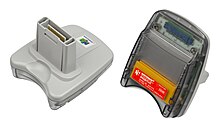
The Transfer Pak[e] (NUS-019) plugs into the controller to transfer data between supported Nintendo 64 games and Game Boy or Game Boy Color games.[14] It has a Game Boy Color slot and a part that fits onto the expansion port of the N64 controller. It was included with the game Pokémon Stadium.
In Japan it is called "64GB" as Shigeru Miyamoto described at Nintendo's Space World 1997 trade show. It was a key feature of the infamous creature raising game prototype that was never released, Cabbage.[23]
Pokémon Stadium and Pokémon Stadium 2 are games that rely heavily on the Transfer Pak, as the games' main feature is importing Pokémon teams from the Game Boy games. Pokémon Stadium also includes a "GB Tower" mode for playing Pokémon Red, Blue, and Yellow directly on the Nintendo 64 via a built-in Game Boy emulator.[24]
The Japanese version of the Game Boy Camera can be connected to the Mario Artist series.[25] Mario Golf and Mario Tennis allow players to transfer their created characters from the Game Boy Color versions to the Nintendo 64 versions via the Transfer Pak.[26][24] Rare's Perfect Dark was initially going to be compatible with the Transfer Pak in order to use pictures taken with the Game Boy Camera to create characters with real-life faces, but this function was removed from development after the attacks at Columbine High School and a wave of anti-violent video game sentiment; the Transfer Pak is usable only in combination with the Game Boy Color version of Perfect Dark for unlocking bonuses.[27][24]
Wide-Boy64[]
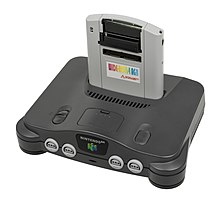
Developed by Intelligent Systems, the Wide-Boy64 is a series of adapters similar to the Super Game Boy that was able to play Game Boy games. The device was never sold in retail to general consumers and was only provided to developers and the gaming press. Two major versions of Wide-Boy64 were released: the CGB, which could play Game Boy and Game Boy Color games, and the updated AGB, which could also play Game Boy Advance game paks. It also allowed the gaming press to capture screen shots more easily. Like the Super Game Boy and Game Boy Player, the game screen is surrounded by a template mimicking the appearance of the portable system. This device was used for final matches at the Pokémon League Summer Training Tour '99. Developers and magazines could purchase one directly from Nintendo at a cost of $1400 apiece. The Canadian children's game show Video & Arcade Top 10 used Wide-Boy64 adapters so contestants could play Game Boy titles on some later episodes.
S-Video Cable[]
The S-Video Cable provides a better quality picture than composite RCA cables via the MultiAV port. The NTSC cable is identical to and compatible with earlier SNES (NTSC/PAL) and later GameCube (NTSC-only) S-Video cables. The first party NTSC Nintendo 64 S-Video cable sold by Nintendo, however, was not produced in PAL regions. The PAL Nintendo 64 does natively output S-Video (Luma/Chroma),[34] but require a different cable to NTSC Nintendo 64 due to a design difference in most or all PAL motherboard revisions. Nintendo never released an official S-Video cable for the PAL console. Using an NTSC S-Video cable on a PAL console will usually produce over-bright, garish colors; or it may not produce any video image at all.[35]
Third party S-Video cables for both the NTSC and PAL consoles were produced, though it is important to note that many cheaper S-Video cables do not deliver a true S-Video signal, merely passing the composite video signal (the yellow plug of the standard red/white/yellow AV cables) through the S-Video plug.[36]
64DD[]

The 64DD (NUS-010) is a 64 MB floppy drive with real-time clock, font and audio library in ROM, and a bundle of other accessories and custom games. The peripheral was initially announced in 1995, planned for release in 1997, and repeatedly delayed until its release in December 1999. It was launched alongside a now defunct online service called Randnet. With nine games released, it was a commercial failure and was consequently never released outside Japan.
Mouse[]

The mouse (NUS-017) was developed for the 64DD's GUI-based games and applications, such the Mario Artist suite, SimCity 64, and the web browser for Nintendo's defunct online service Randnet. It was manufactured by Mitsumi and bundled with the 64DD's launch game, Mario Artist: Paint Studio.[38][39] It works with the Game Pak Mario no Photopi.[f]
VRU[]

The VRU or Voice Recognition Unit (NUS-020, NUS-021, NUS-022, and NUS-025) is compatible with only two games: Hey You, Pikachu! and Densha de Go! 64. Hey You, Pikachu! is packaged with the VRU and requires it, but Densha de Go! 64 does not and is sold separately. The VRU consists of a ballast (NUS-020) connected to controller port 4 of the system, a microphone (NUS-021), a yellow foam cover for the microphone, and a clip for clipping the microphone to the controller (NUS-025, bundled with Hey You, Pikachu!) or a plastic neck holder for hands free usage (NUS-022, bundled with Densha de Go! 64). The VRU is calibrated for best recognition of a high-pitched voice, such as a child's voice. As a result, the voices of adults and teenagers are less likely be recognized properly by the VRU.
VRUs are region dependent, and a USA region VRU cannot be used with Japanese games and vice versa (foreign region VRUs are not detected by the games). No VRU compatible game was launched in the EUR region (PAL, Europe), so there is no EUR-region VRU. A similar device was also released for the Wii called the Wii Speak.
Cleaning Kit[]
The cleaning kit (NUS-014, NUS-015, and NUS-016) contains materials to clean the connectors of the Control Deck, controllers, Game Paks, Rumble Paks, and Controller Paks.
RF Switch and RF Modulator[]
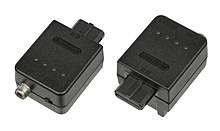
The RF Switch and RF Modulator (NUS-009 and NUS-003) allow the Nintendo 64 and model 2 SNES (redesigned after the launch of the Nintendo 64) to hook up to the television through RF. It was primarily intended for customers with older televisions that lack AV cable support. Since the Nintendo 64 and model 2 SNES lack built-in RF compatibility, the modulator acts as a special adapter that plugs into the Nintendo 64's AV port to give the Nintendo 64 RF compatibility. The RF switch itself is identical in every way to the RF switches released for Nintendo's prior systems (the NES and the SNES) and can be interchanged if needed. This set was later re-released for the GameCube to give it RF capability. The cables intended for the GameCube will also work with the Nintendo 64 and SNES.
Euro Connector Plug[]
The Euro Connector Plug is an adaptor packaged with European releases of the console, which converts RCA composite and stereo cable inputs to Composite SCART.
Video capture cassette[]
The video capture cassette, or cartridge, (NUS-028) for use on the Mario Artist[g] 64DD game series. The back of the cartridge has audio, video, and microphone input jacks through which it can collect video and audio data.[40] It was bundled with the 64DD game. Mario Artist - Talent Studio.[h]
Modem[]
The modem cartridge (NUS-029) connects at up to 28.8 kbit/s, formerly for use with the Randnet service and compatible 64DD games and web browser.
Power supply[]
The power supply (NUS-002, UKV-EUR-AUS-JPN-USA) provides electricity to the Control Deck.
Keyboard[]
The compact keyboard is for use with the Randnet service and compatible 64DD games.
SmartMedia[]

SmartMedia memory cards for use with the game Mario no Photopi[i] contain images, backgrounds, borders, and other media assets to be used while editing the user photos. There are at least six different cards:
- Illustrations - Postal cards 1[j]
- Illustrations - Funny accessories 1[k]
- Characters collection - Yoshi's Story[l]
- Characters collection - Sylvanian Families[m]
- Characters collection - Bomberman[n]
- Characters collection - The Legend of Zelda - Ocarina of Time[o]
- Characters collection - Himitsu no Akko-chan[p]
- Characters collection - Hello Kitty[q]
- Characters collection - Card Captor Sakura[r]
- Characters collection - Medarot[s]
The cards are all 3.3 V 2 MB SmartMedia memory cards manufactured by Hagiwara Sys-Com. The Mario no Photopi game was bundled with an empty memory SmartMedia card for storing the user creations.
Licensed[]
ASCIIWHEEL 64[]
The ASCIIWHEEL 64 is an alternate controller shaped as a steering wheel for driving games. It includes a slot for the Controller Pak and other controller accessories.[41]
Bio Sensor[]

The Bio Sensor (NUS-A-BIO-JPN) is an ear clip that plugs into the Controller Pak slot of the controller to measure the user's heart rate.[40] It was manufactured by Seta and released only in Japan. It is compatible only with Tetris 64, which slows down or speeds up depending on how fast the player's heart is beating. This device is similar to the Wii Vitality Sensor.
Tsuricon 64[]
The Tsuricon 64[42] (ASC-0905) is a fishing controller manufactured by ASCII Corporation and compatible with a few Japanese fishing games, like Bass Rush - ECOGEAR Power Worm Championship,[t] The Legend of the River King 64 - Riding the sea breeze,[u] or Itoi Shigesato no Bass Tsuri No.1 Definitive Edition![v]
Densha de Go! controller[]
A train controller compatible with just one game: Let's go by Train! 64.[w] It is similar to other controllers for the same game series on different platforms such as Dreamcast and PlayStation. The game optionally supports the VRU.
System Organizer[]
Nintendo licensed A.L.S. Industries to make two types of black wooden system organizers. Both feature a plastic drawer, bearing a Nintendo 64 sticker, with slots designed to hold Nintendo 64 game cartridges, controllers, and Controller Paks.
Traveling accessories[]
The Messenger Bag is a black bag made to carry on the left side of the body. It is branded on the front with the Nintendo 64 logo and name. It comes with zippered compartments on the outside and inside and with mesh pockets, for a few games and a controller.
Nintendo licensed a Traveling Case—a black bag, with the Nintendo 64 name stitched on the front. Two plastic buckles on the front keep the bag closed. It is made to carry the Nintendo 64 system with controllers, games, and accessories. They also made a standard black backpack with the Nintendo 64 logo on the top and a zippered compartment on the front.
Camera[]
A basic 35 mm camera, complete with a timer and flash. Official cameras have a Nintendo 64 logo on the front. They come in different colors such as blue and orange.
Development and backup[]

Nintendo's original development environment for Nintendo 64 software is a card made by SGI containing most of a Nintendo 64 console, plus a software development kit (SDK), for self-hosted installation in an SGI Indy workstation.
The second generation moved to a much cheaper partner model between a normal Nintendo 64 console and a PC, by providing a cartridge form factor holding flash storage with a cable connection to a PC. Nintendo officially licensed SN Systems to make the SN Systems dev kit and SN Maestro 64, the second generation of Nintendo 64 SDK in PC partner form to replace the Indy-hosted hardware solution. Unofficial kits include IS-VIEWER 64 and Partner 64. The Monegi Smart Pack is a collection of third party hardware and software which can be used to do real-time development while the game is running on the console.
Through the decades, many unlicensed third party peripheral devices provide many consumer-friendly alternative storage mediums for retail Nintendo 64 consoles, bypassing console security for the purpose of development or for users making backups of game cartridges and save data. The Doctor V64 is a CD-ROM peripheral designed by Bung Enterprises Ltd and released in 1996. It plugs into the Nintendo 64's underside expansion slot, and uses a lockout-bypass adaptor that fits into the cartridge port into which any retail cartridge is inserted for use of its lockout chip by proxy. The Doctor V64 Jr. is a cheaper, condensed version that fits into the cartridge port and provides a parallel port connection to a PC. Bung made the DX 256 Super Game Saver[43] which stores 256 battery EEPROM save states, and the DS1 Super Doctor Save Card. The CD 64 is a CD-ROM drive developed by UFO/Success Company. Mr. Backup Z64 designed by Harrison Electronics, Inc. is a ZIP drive peripheral for creating writable backups and performing playback of any Nintendo 64 cartridge. The modern Everdrive 64, ED64 Plus, N64 Neo Myth, and 64Drive use SD cards for mass storage of ROM image files or USB cables to connect to a PC for transfer.
Unlicensed[]

- Glove Controller is a wearable controller with buttons like a normal controller, usable in any game.
- Tilt Pak is a rumble feedback and motion sensor made by Pelican.
- GameShark is an unlicensed cheat device made by Interact in two versions. The first version has an LED display and a slot on the back of the unit for an expansion card that was never made. The second version (known as the "Pro" series, versions 3.2 and up) has a parallel port on the back for connecting to a computer for game downloads. GameShark cards (or Action Replay cards in Europe) can be used to access cheat content.
- SharkWire Online is an InterAct GameShark with modem and PC style serial port for keyboards. It allowed emailing and Game Shark updates through the now discontinued sharkwire.com dial-in service.
- GB Hunter is a Game Boy player, similar to the first-party Super Game Boy for the SNES.
- High Rez Pack — Mad Catz's less-expensive version of the Expansion Pak.[44] There were reports of overheating due to inadequate cooling/venting, and the unit suffered from poor build quality.[citation needed]
- N64 Passport is an adaptor and cheat device allowing players to play games from different regions, with a few exceptions.
- Memory Card Comfort by Speed-Link is a controller expansion with four separate memory areas, and 123 pages each, selectable via a small switch.
- Tremor Pak is a third-party rumble expansion.[45]
- The Nyko Hyper Pak Plus contains internal memory and a rumble feature.[46]
- Advanced Controller is a Mad Catz gamepad with the same form and controls as the standard Nintendo 64 controller, plus a turbo button.[47][48]
- Mad Catz Steering Wheel is a set consisting of an analog steering wheel that turns 270 degrees, two foot pedals, and a stick shift.[47][48]
- Power Wheel is a steering wheel with foot pedal module produced by Game Source.[49]
- V3 Racing Wheel is a steering wheel with foot pedals produced by Interact. It includes an expansion port which does not support the Rumble Pak, due to the risk that it would grate on the player's crotch.[50]
- Flight Force Pro 64 is a flight stick from InterAct.[51]
- Arcade Shark is an arcade-style joystick controller from InterAct, with slow motion and auto-fire buttons.[48]
- Tristar 64 is a third party adaptor enabling NES and SNES games on Nintendo 64. The device expands the cartridge slot into three total slots for each cartridge type.
- Interact reportedly had two Nintendo 64 light guns "packed and ready to ship", one of them with built-in force feedback, but never released them due to the complete lack of light gun shooters for the console.[52]
Notes[]
- ^ Japanese: コントローラパック, Hepburn: Kontorōra Pakku
- ^ Known in Japan as Terminator Pack (Japanese: ターミネータ パック, Hepburn: Tāminēta Pakku)
- ^ Japanese: 拡張パック, Hepburn: Kakuchō Pakku
- ^ Japanese: 振動パック, Hepburn: Shindō Pakku
- ^ Known in Japan as 64 GB Pack (Japanese: 64GBパック, Hepburn: Rokujūyon Jī Bī Pakku)
- ^ Japanese: マリオのふぉとぴ
- ^ Japanese: マリオアーティスト
- ^ Japanese: マリオアーティスト タレントスタジオ
- ^ Japanese: マリオのふぉとぴ
- ^ Japanese: イラスト集 ポストカード 1
- ^ Japanese: イラスト集 おもしろアクセサリー 1
- ^ Japanese: キャラクター集 ヨッシーストーリー
- ^ Japanese: キャラクター集 シルバニアファミリー
- ^ Japanese: キャラクター集 ボンバーマン
- ^ Japanese: キャラクター集 ゼルダの伝説 - 時のオカリナ
- ^ Japanese: キャラクター集 ひみつのアッコちゃん
- ^ Japanese: キャラクター集 Hello Kitty
- ^ Japanese: キャラクター集 カードキャプターさくら
- ^ Japanese: キャラクター集 メダロット
- ^ Japanese: バスラッシュ - ECOGEAR Power Worm Championship
- ^ Japanese: ぬし釣り 64 潮風にのって/ Nushi Tsuri 64 - Shiokaze Ninotte
- ^ Japanese: 糸井重里のバス釣り No.1 決定版!
- ^ Japanese: 電車 で GO! 64, Hepburn: Densha de Go! 64
References[]
- ^ Lane, Gavin (May 6, 2020). "Nintendo Console Codenames And Product Codes". Nintendo Life. Archived from the original on September 17, 2020. Retrieved September 25, 2020.
- ^ Kelly, Mark. "Nintendo 64 Hardware and Accessories". nindb.net. Archived from the original on December 1, 2019. Retrieved September 25, 2020.
- ^ Casamassina, Matt (February 23, 1999). "Nintendo 64 Mailbag". IGN. Archived from the original on July 19, 2007. Retrieved October 3, 2007.
- ^ "GB HUNTER Related Articles This is a list of accessories for t". Amazines.com. Archived from the original on July 7, 2011. Retrieved May 12, 2010.
- ^ "Mantop!!! - Nintendo 64". Dinkacak.multiply.com. Archived from the original on February 14, 2010. Retrieved May 12, 2010.
- ^ Thomas, Lucas M. (January 30, 2007). "Mario Kart 64 VC Review - Wii Review at IGN". Wii.ign.com. Archived from the original on February 13, 2009. Retrieved May 12, 2010.
- ^ Scott McCall (April 4, 2000). "Archive 64: Tony Hawk's Pro Skater - Nintendo 64 (N64) Review". Pennoaks.net. Retrieved May 12, 2010.
- ^ "Who Won the Videogame Wars of 1996?". Next Generation. No. 28. Imagine Media. April 1997. p. 17.
- ^ Jump up to: a b "Installing the Nintendo 64 Expansion Pak". Nintendo - Customer Service. Nintendo of America Inc. Archived from the original on May 4, 2010. Retrieved November 1, 2009.
- ^ Jump up to: a b c d "Nintendo 64 Tech". Icequake.net. Ryan C. Underwood. May 17, 2007. Archived from the original on April 30, 2009. Retrieved November 1, 2009.
- ^ The Watch Dog (November 1997). "Buyers Beware". GamePro. No. 110. IDG. p. 28.
- ^ Taruc, Nelson (November 22, 1999). "Donkey Kong 64 Review". GameSpot. Archived from the original on August 30, 2016. Retrieved December 17, 2016.
- ^ Jump up to: a b c "Expansion Pak Games". Nintendo of America. Archived from the original on April 13, 2001. Retrieved January 11, 2014.
- ^ Jump up to: a b c "Accessories". Nintendo 64. Nintendo of Europe. Retrieved July 21, 2014.
- ^ Jump up to: a b c Buchanan, Levi (October 29, 2008). "N64 Expansion Pak". IGN. Retrieved September 5, 2014.
- ^ "Buyers Beware". GamePro. No. 132. September 1999. p. 29.
- ^ "Nintendo Sports: Baseball: All-Star Baseball 2000". nintendosports.com. Nintendo Sports. c. 2000. Archived from the original on March 2, 2000. Retrieved September 21, 2020.
If you pop in an Expansion Pak, though, you'll witness extra-long replays.
- ^ IGN Staff (May 12, 1999). "Donkey Kong Enforces 4MBs". IGN. Archived from the original on December 21, 2016. Retrieved December 19, 2016.
- ^ Watts, Martin (May 28, 2013). "Donkey Kong 64 Required Expansion Pak to Prevent Game-Breaking Bug". Nintendo Life. Archived from the original on December 20, 2016. Retrieved December 18, 2016.
- ^ Lane, Gavin (November 23, 2019). "Feature: Donkey Kong 64 Devs On Bugs, Boxing And 20 Years Of The DK Rap". Nintendo Life. Retrieved May 30, 2020.
- ^ IGN Staff (May 20, 1999). "Kong/Expansion Pak Bundle Absolute". IGN. Archived from the original on December 21, 2016. Retrieved December 19, 2016.
- ^ "Nintendo 64 Rumble Pak". Nintendo of America. Archived from the original on December 1, 2000. Retrieved August 10, 2020.
- ^ Miyamoto, Shigeru (November 25, 1997). "Miyamoto Meets N64.com" (Interview). Interviewed by Peer Schneider and Douglass Perry. Retrieved August 6, 2020.
- ^ Jump up to: a b c d IGN Staff (September 14, 2001). "Connecting to the Cube". Retrieved August 7, 2020.
- ^ Jump up to: a b "GDC: Miyamoto Unveils Camera Connection". IGN. March 18, 1999. Archived from the original on June 10, 2001. Retrieved November 20, 2015.
- ^ IGN
- ^ Hiranand, Ravi (February 10, 2000). "Rare Cleans Up Perfect Dark". GameSpot. Archived from the original on December 30, 2011. Retrieved January 16, 2011.
- ^ "Nintendo Still Cooking Cabbage". IGN. April 4, 2000. Archived from the original on February 23, 2014. Retrieved February 25, 2014.
- ^ Jump up to: a b IGN Staff (January 29, 1998). "64DD: The Games". Archived from the original on January 29, 2015. Retrieved January 25, 2015.
- ^ Miyamoto, Shigeru; Itoi, Shigesato (December 1997). "A friendly discussion between the "Big 2"". The 64DREAM. Translation. p. 91.
- ^ Gantayat, Anoop (August 21, 2006). "Miyamoto Opens the Vault". IGN. Archived from the original on September 24, 2015. Retrieved January 28, 2015.
- ^ "What's DT, you ask?". IGN. August 27, 1999. Archived from the original on December 20, 2004. Retrieved January 3, 2015.
- ^ Schneider, Peer (August 27, 1999). "Mario Artist: Talent Studio (Import)". IGN. Archived from the original on January 29, 2015. Retrieved January 25, 2015.
- ^ "S-Video on PAL N64 (pics, details inside)". nfggames.com. Archived from the original on November 6, 2014. Retrieved September 18, 2014.
- ^ "Help with N64 svideo - overbright image".
- ^ "Any recommendations on an S-Video cable for SNES, N64, or GameCube?". digitpress.com.
- ^ Byrne, Brian C. (August 4, 2019). History of Nintendo: Volume One (Console Gamer Magazine). Console Gamer Magazine. Retrieved June 4, 2020.
- ^ Byrne, Brian C. (August 4, 2019). History of Nintendo: Volume One (Console Gamer Magazine). Console Gamer Magazine. Archived from the original on June 5, 2020. Retrieved June 5, 2020.
- ^ "Nintendo Mouse". IGN. May 12, 1998. Archived from the original on April 23, 1999. Retrieved November 20, 2015.
- ^ Jump up to: a b "Peripheral Visions". Electronic Gaming Monthly. No. 103. Ziff Davis. February 1998. p. 21.
- ^ "ASCIIWHEEL 64". Nintendo of America. Archived from the original on December 1, 2000. Retrieved August 10, 2020.
- ^ Japanese: つりコン64
- ^ IGN Staff (February 26, 1999). "DX 256 - Super Game Saver". IGN. Retrieved February 16, 2019.
- ^ "Mad Catz High-Rez Pack". IGN. June 2, 1999. Archived from the original on September 26, 2020.
- ^ "TremorPak Plus". IGN. March 3, 1999. Archived from the original on March 31, 2007.
- ^ "Hyper Pak Plus". IGN. June 12, 1998. Archived from the original on March 30, 2007.
- ^ Jump up to: a b "Mad Catz Gets Into N64 Act" (PDF). Electronic Gaming Monthly. No. 86. Ziff Davis. September 1996. p. 17. Archived (PDF) from the original on August 21, 2019.
- ^ Jump up to: a b c "GamePro Labs". GamePro. No. 96. IDG. September 1996. p. 36.
- ^ "Multisystem Drivin'" (PDF). Electronic Gaming Monthly. No. 95. Ziff Davis. June 1997. p. 22. Archived (PDF) from the original on July 7, 2020.
- ^ "Fuel-Injected Gaming" (PDF). Electronic Gaming Monthly. No. 97. Ziff Davis. August 1997. p. 26. Archived (PDF) from the original on July 27, 2020.
- ^ "Flight for N64: InterAct First to Make 64-Bit Flight Sim Stick" (PDF). Electronic Gaming Monthly. No. 88. Ziff Davis. November 1996. p. 22. Archived (PDF) from the original on March 27, 2020.
- ^ "Buyers Beware". GamePro. No. 107. IDG. August 1997. p. 18.
- Nintendo 64 accessories
- Nintendo 64
